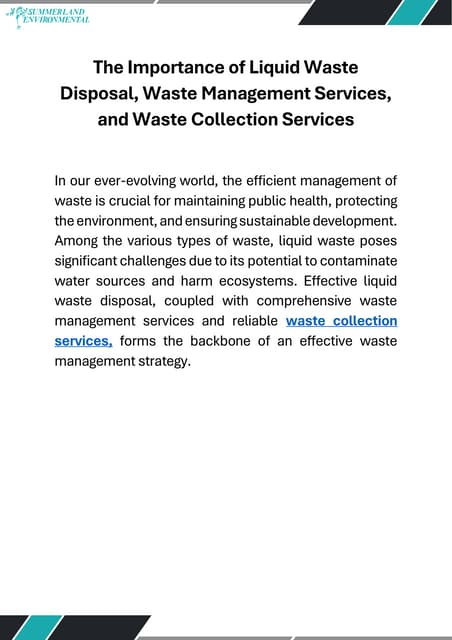The 9-Minute Rule for Reclaim Waste
The 9-Minute Rule for Reclaim Waste
Blog Article
Reclaim Waste - Questions
Table of ContentsReclaim Waste Things To Know Before You Get ThisWhat Does Reclaim Waste Do?Fascination About Reclaim WasteThe 6-Minute Rule for Reclaim WasteReclaim Waste Fundamentals Explained
Residential sewer waste refers to the waste and products from a residential septic tank. The appropriate management and disposal of domestic sewer waste require fluid waste to be transferred to a sewer treatment plant where the appropriate methods and devices are used to cleanse and dispose of waste.
Industrial waste often includes prospective risks, such as flammable materials or a mix of liquid and solid waste products, and needs a much more innovative and detailed disposal process. The disposal of business waste normally involves the purification of waste prior to transport to make sure secure and appropriate disposal. Industrial waste is developed from byproducts and runoff of commercial procedures and production.
This kind of waste can not use the same sewage management transportation or procedures as septic or industrial liquids. The hazardous waste administration procedure needs the inspection and screening of fluid waste prior to it undergoes the disposal procedure (liquid waste removal). Overflow waste is the liquid waste that originates from overflow and excess stormwater in highly populated areas or cities
Overflow waste can create contamination and flooding otherwise dealt with correctly. Learn a lot more concerning sewer cleaning and waste monitoring. Making certain correct waste monitoring can prevent disasters and decrease ecological injury. Both people in household setups and professionals in commercial or production markets can gain from understanding the processes and regulations of fluid waste monitoring.
Reclaim Waste Can Be Fun For Anyone
Call PROS Providers today to discover our waste management and disposal solutions and the proper means to take care of the fluid waste you generate.
(https://medium.com/@leonaube33101/about)Do you know what happens to your water when you end, flush the toilet or drain pipes the cleaning equipment? No? Well, it deserves recognizing. This so-called 'wastewater' is not just an important resource however, after treatment, will be launched to our land, waterways or the ocean. Used water from commodes, showers, bathrooms, kitchen sinks, laundries and commercial processes is called wastewater.

water my review here used to cool equipment or clean plant and tools). Stormwater, a form of wastewater, is runoff that streams from farming and urban areas such as roofing systems, parks, yards, roadways, paths and seamless gutters into stormwater drains pipes, after rainfall. Stormwater streams without treatment straight to local creeks or rivers, ultimately getting to the sea.
The Best Strategy To Use For Reclaim Waste
In Queensland, most wastewater is dealt with at sewage treatment plants. Wastewater is delivered from domestic or commercial sites through a system of sewers and pump terminals, recognized as sewage reticulation, to a sewer treatment plant.
The Division of Natural Resources suggests city governments regarding handling, operating and preserving sewage systems and treatment plants. In unsewered locations, city governments might require homeowners to install private or household sewer therapy systems to deal with residential wastewater from bathrooms, cooking areas, restrooms and laundries. The Division of Natural Resources authorizes the use of house systems when they are shown to be effective.
In some brand-new neighborhoods, therapy of some stormwater to remove trash, sand and crushed rock has started utilizing gross contaminant traps. Wastewater treatment happens in four phases: Eliminates solid issue.
Wastewater after that flows into huge tanks where solids settle and are eliminated as sludge. Oil and scum are skimmed from the surface area. Makes use of small living organisms called micro-organisms to damage down and remove continuing to be dissolved wastes and fine fragments. Micro-organisms and wastes are integrated in the sludge. Gets rid of nitrogen and phosphorus nutrients that could trigger algal flowers in our waterways and intimidate aquatic life.
The Basic Principles Of Reclaim Waste
Nutrient removal is not available at all sewer treatment plants due to the fact that it calls for costly specialised tools. Clear fluid effluent generated after therapy might still consist of disease-causing micro-organisms - liquid waste disposal melbourne.

This generally means wastewater has to be treated or contaminants removed prior to it can be discharged to rivers. Many wastewater moves right into the sewerage system. Under the Act, regional federal governments administer authorizations and permits for eco relevant tasks (Ages) including wastewater launches that could have a neighborhood effect. The division carries out approvals and permits to ERAs involving wastewater releases that might have a local or statewide influence.
More About Reclaim Waste
Or else, examples are taken for laboratory evaluation. Commonly numerous tests are required to develop the degrees of each of the various pollutants such as oils, hefty steels and pesticides in water. Surveillance supplies factual details regarding water quality and can validate that permit conditions are being met. The information gotten via monitoring supplies the basis for making water quality choices.
Report this page